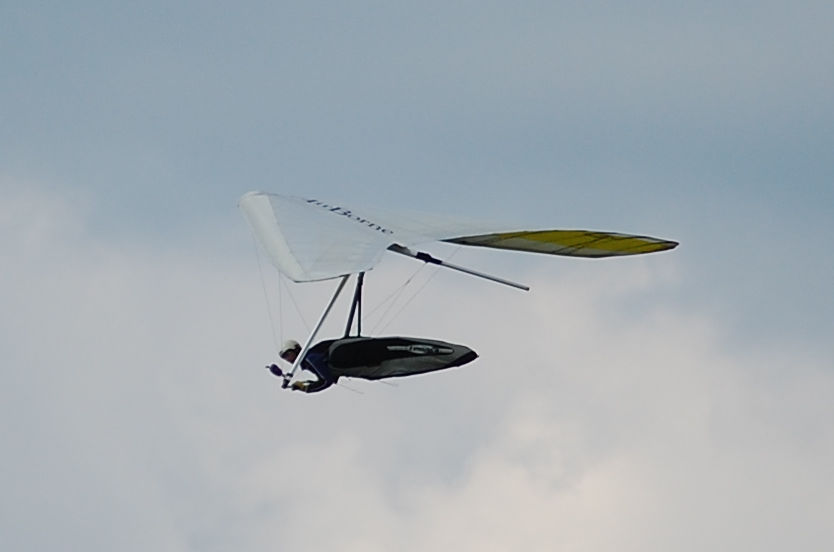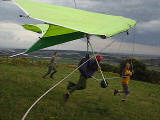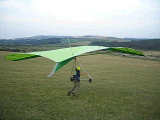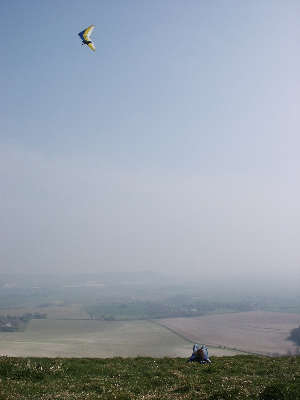Hang Gliding Introduction - South Downs Hang Gliding
 Sky Surfing
Sky Surfing
A glider is an unpowered aircraft that slides down through the air. A Hang Glider is a true glider in this sense: it slides down through the air on a slope created by the shape of its wings. If the air is perfectly still, it will glide down this slope at about 20 mph sinking gently at less than 2 mph, without the pilot doing anything! Save perhaps resting the hands lightly on the control bar. This is the majestic state of "cruise" aboard your wings where you simply enjoy the view, the glider by design neither changes its speed or direction until you swing your weight by moving the control frame. If the air through which your're moving is rising greater than 2mph then your're soaring, all the time sliding down, through the air, but gaining height by riding the air currents.
Windspeed, Groundspeed and Airspeed
When there is a wind the glider's flight is unaffected, it still slides down through the air, only the speed over the ground will change when flying up- or down-wind. In a 30 mph wind a glider with an airspeed of 30 mph will not be moving over the ground when flying directly into wind, but, after a 180' turn will have a groundspeed of 60 mph! All aircraft take-off and land into wind to reduce groundspeed. Modern hang-gliders can fly as fast as 70mph by increasing the dive, but to fly in winds over 30mph is unrewarding. This speed through the air is called airspeed. When the air is moving over the land, we have a windspeed. The speed of the glider over the ground is the combination of these two, the groundspeed.
Weight-shift Control and the Stall
Hanging from one point on the keel of the glider you can swing your weight anywhere within reach of your arms to alter the speed and direction of the glide. Hence the English name hang-gliding, hanging in a harness of flexible webbing from the one hang-point like a pendulum. Pulling the weight forward towards the nose makes the glider adopt a steeper glide slope and it increases speed, shifting the weight to the side makes the glider roll and turn. Pushing your weight back makes the nose rise, lessening the slope, reducing the speed. However, there is a minimum flying speed of about 12 mph where the angle of the airflow becomes too steep and the wing begins to stall. By design the hang-glider is not a parachute, it's the wrong shape. When flown slower than this critical speed the nose will automatically drop, whereupon the flying speed will be regained. From the moment the glider pitches down there follows 2 or 3 seconds where the pilot has no control. If flown too slowly the wing will stall, dive and swoop, losing a height of 50 or 60 feet in the manoeuvre. When flying below this critical height the pilot should always fly with a little extra airspeed for safety. It is important for the student to be aware that the cause of most hang-gliding accidents can be attributed to flying too slow too low.
The Weather
Hang-gliding exploits favourable air conditions. An understanding of the weather will enable a successful choice of site and provide a knowledge of the day's flying potential. There is tremendous power in the sky and to attempt to fly without understanding the air movements would be suicidal. Learning to fly will be accompanied by studying the weather. Wind speed and direction are the initial concerns. If its greater than 25mph it may be too strong for a pleasant flight. The direction is important for choosing the launch site where the wind should blow directly up slope to provide lift. Take-offs and landings need to be made into wind to reduce groundspeed. The stability of the air, whether it is likely to convect as thermals or become broken and rough is a further concern before commiting oneself into the air. Whether to fly depends on the weather.
 Lessons
Lessons
It would be foolish to start hang-gliding by jumping off the nearest hill. The sensation, the control and the feedback can only be acquired safely by repeated attempts under the tuition of an experienced flyer and qualified instructor. A first bike ride may involve stabiliser wheels or your Dad running along holding the saddle, your first flights will have wheels attached to the control-bar and tether ropes from the wings and nose of the machine.
Launch and Landing
Launching involves supporting the wing then accelerating up to the cruise speed by running from a hill or being pulled by a tow-line, again, using the feet as the undercarriage. On launch and landing the glider is held by the sides of the control-frame, the pilot in an "upright" position. When airbourne, a prone position is adopted by swinging the legs up into the pod-like harness, which are then tucked neatly away by a long zip-up front. Landing is the reverse procedure: remove the legs from the harness (undercarriage down), adopt the upright position, approach with a little extra speed for safety then round out to skim along near the ground slowing the glide. When slow enough begin to run, then finally support the glider with the shoulders. In very light winds a hard push out on the control frame when near the stall speed reduces airspeed to near zero. This nose up rotation is called the "flare" and enables the pilot to land gently without the need to run.
Structure of a Hang Glider
The glider consists of the airframe, (the tubes, wires, etc.), and the sail. The sail is the main part of the hang-glider. Sailcloth is made from a type of terelyne, it's strong and wind-proof. Various thicknesses are used. It is the same cloth as used on wind-surfers or sail boats. Hang-gliders come in various sizes like T-shirts: small, medium, and large, which today amounts to sail areas of about 12, 14, and 16 sq. metres. The "wing-loading", the weight supported per unit area, is surprisingly low, only about 6 kg per square metre. The strength of the cloth is comparitively large, easily able to withstand 10 times that loading. Although the sail may look flimsy, it is usually by far the strongest part of the glider. Over the 35 years or so of the sport most of the technological progress involves improving the shape of the sail. This involves highly skilled sailmakers working to produce a complex 3D shape with the utmost precision. The Airframe consists of three tubes of aluminium joined at the nose, two cross-tubes which hold the wings apart, a triangular control-frame, and a strut above the wing called the king-post. These are all braced together by wires which triangulate the structure. Battens made of thin aluminium tube brace the sail from the front to the back. These are shaped to maintain the aerofoil.
 Rigging
and Ground Handling
Rigging
and Ground Handling
The hang-glider spends most of its life inside a 20ft bag by about 1ft diameter , folded at the nose, all the wing structure contained within the D-shape of the stiffened leading-edge. The whole pack weighs an awkward 50 lbs. Rigging the glider takes approximately 15minutes. The pack is first placed on the ground with the nose pointing into the direction of the wind. The bag is unzipped and the control-frame assembled. Then the whole pack is turned over and the bag removed. The wings can now be opened out and the battens inserted. Finally, the tension is applied, by pulling back the cross-tubes, and secured. Lifting the glider up and back the control frame rotates to the upright postion bringing the wing, and rear-wires, up to tension, then the nose wires are attached and the machine is ready to fly. If this is the first flight of the day then the pilot will complete a pre-flight inspection of the whole wing , often with the aid of an assistant to hold the nose. Once satisfied that the glider is correctly rigged and in good condition, the harness can be put on and connected to the hang-strap on the keel. In gusty or strong winds an assistant holding the front wires will help to control the glider on the ground before take-off.
 Ridge
Soaring
Ridge
Soaring
When a breeze blows directly up the slope of a hill there is an opportunity to remain airboune for a prolonged flight. Note, the air must be rising faster than the glider descends through the air. If this is the case then the glider, kept within this rising lift-band, will ascend until an equlibrium is reached where the speed of descent matches the rising of the air. On a good day this can be at a height of twice that of the particular hill. That is twice the hill height above take-off. A 500ft hill when the air is of the right bouyancy and wind speed will provide as much as 1000ft of height gain in which the pilot can swoop and soar. It is easily possible to fly all day long when the wind remains constant in strength and direction. However, unless the pilot is undertaking some duration challenge, it would be usual for individual flights to last about an hour, plenty of time to explore the available lift, to cruise around and enjoy the view. On a typical day of hill soaring at the appropriate local site there may be many gliders in the air flying up and down the length of the ridge. There will be other parked gliders and fairly close by a group of pilots standing in their harnesses looking like a collection of penguins!
Top Landing
With a good landing area on top of the hill, the pilot can land and take-off several times a day. By first losing height to about 150ft the glider is then flown behind the lift-band to a position downwind of the landing area where a staight glide will arrive at the desired landing spot. As a rule, we do not fly downwind of objects (trees and buildings etc.) to avoid turblence. Also, we can fly straight out again if still too high. Even the best pilots will be seen to occasionally overshoot on top-landing, as the lift on the landing approach can be unpredictable.
Thermal Soaring
Thermal lift is available during the summer which can take the pilot right up to the base of the clouds. These columns of warm rising air are best accessed from hill soaring, where they will drift towards and past the hill, taking the skilled pilots up and away with them. Another way to get into thermal lift is by an aerotow from a microlight, where the pilot can release directly into the thermal. In England the summer cloud-base can reach 6000ft giving a superb view of the countryside from over a mile high! From such heights the glider has every chance of encountering another thermal , thus regaining height. This process, thermal soaring, can continue all day until the sun's rays become to low for convection to carry on. The record distance flown by thermal soaring now stands at over 600km!
South Downs Hang Gliding
Gibraltar
Farm, Firle, East Sussex. BN8 6NB
Tel. 07890 362648
E-mail: info@southdownshanggliding.co.uk